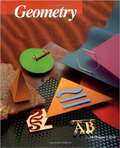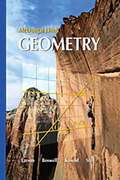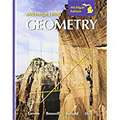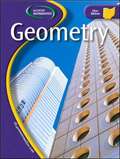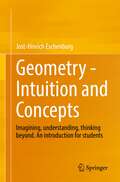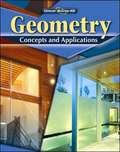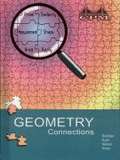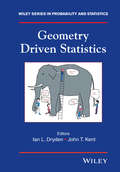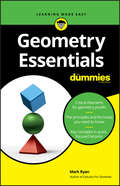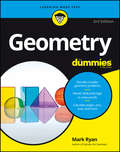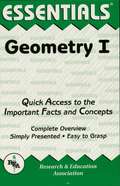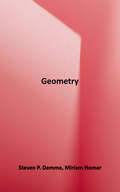- Table View
- List View
Geometry
by Richard G. Brown Ray C. Jurgensen John W. JurgensenThis book provides exploratory exercises that lead students to discover geometric properties and develop geometric intuition.
Geometry
by Kathy D. Pilger Ron TagliapietraIn this textbook, every chapter contains biblically based material, providing a scriptural foundation. Questions about the Bible text help you grasp what is important to the chapter. The Bible as truth makes what you learn personal and practical. The Bible as the basis for geometry sheds light on the purpose of the subject. The theme verse helps you to link the temporary with the eternal in your studies. Many examples help you do the homework. Two-column proofs help you develop your reasoning skills. Exercises with different levels of difficulty help guide your progress. Dominion Thru Math helps you apply technology to problem solving. Level C exercises challenge your thinking skills. Cumulative Reviews help you stay on top of the subject. Geometry Around Us reveals some of geometry’s secret hideouts. Analytic Geometry helps you make the algebra- geometry connection. Geometry Through History brings the subject to life. The Mind over Math brain teasers exercise your gray matter. Chapter openers are your ticket to new achievements.
Geometry
by Ron Larson Laurie Boswell Timothy D. KanoldAdvanced Placement Calculus is aligned with the NCTM Standards and the latest AP guidelines and retains the solid, carefully motivated mathematics that characterize previous editions. The Seventh Edition embraces the best aspects of reform by integrating the latest technological tools and by emphasizing real-life data, practical applications, and mathematical models.
Geometry
by Ron Larson Laurie Boswell Lee StiffThe book covers basics of geometry in detail with very useful student help sections like Application of Mathematics in real life,Skill Review,Quizzes,Test Preparation techniques etc.
Geometry
by Ron Larson Laurie Boswell Lee Stiff Timothy D. KanoldIn addition to its geometry content, this book includes numerous examples and exercises involving algebra, data analysis, and probability. It also helps students to prepare for standardized tests.
Geometry (Fourth Edition)
by Mark Wetzel Gene Bucholtz Tamera KniselyThe BJU Press Geometry curriculum covers the fundamental key concepts of geometry, including reasoning, proof, parallel and perpendicular lines, triangles, quadrilaterals, area, circles, similarity, an introduction to trigonometry, and more. Fun features are included throughout; "Geometry in history" historical-fiction narratives highlight key mathematical contributions, "Technology Corner" notes use dynamic geometry software to visualize and discover geometric concepts, while "Geometry Around Us" features show how geometry is used in careers and daily life. Chapters introduce the concept and are followed by multiple step-by-step examples. Expanded exercise sets reinforce new concepts and connect skills to previously learned concepts. A cumulative review helps keeps concepts fresh throughout the year.
Geometry (Life of Fred)
by Stanley SchmidtThis is not a traditional math book. This is a child-directed course. The student reads the adventure story, does the math problems that occur as a natural part of the story, and checks their answers (the solutions are right there for the looking.) And learns to love math in the process! (Compare to Saxon at $50-70) Contents: Points and Lines, Angles, Triangles, Parallel Lines, Perpendicular Lines, Quadrilaterals, Area, Geometry Theories, Similar Triangles, Symbolic Logic, Right Triangles, Circles, Constructions, Non-Euclidean Geometry, Solid Geometry, Geometry in 4D, Coordinate Geometry, and Modern Geometry.
Geometry (Maryland)
by Ron Larson Laurie Boswell Timothy D. KanoldThis traditional text offers a balanced approach that combines the theoretical instruction of calculus with the best aspects of reform, including creative teaching and learning techniques such as the integration of technology, the use of real data, real-life applications, and mathematical models. The Calculus with Analytic Geometry Alternate, 6/e, offers a late approach to trigonometry for those instructors who wish to introduce it later in their courses.
Geometry (Michigan)
by Ron Larson Laurie Boswell Lee Stiff Timothy D. KanoldMath textbook for high school
Geometry (Ohio)
by Jerry Cummins Cindy J. Boyd Carol E. MalloyA flexible program with the solid content students need Glencoe Geometry is the leading geometry program on the market. Algebra and applications are embedded throughout the program and an introduction to geometry proofs begins in Chapter 2.
Geometry (Ohio)
by Ron Larson Laurie Boswell Timothy D. KanoldThis traditional text offers a balanced approach that combines the theoretical instruction of calculus with the best aspects of reform, including creative teaching and learning techniques such as the integration of technology, the use of real data, real-life applications, and mathematical models. The Calculus with Analytic Geometry Alternate, 6/e, offers a late approach to trigonometry for those instructors who wish to introduce it later in their courses.
Geometry - Intuition and Concepts: Imagining, understanding, thinking beyond. An introduction for students
by Jost-Hinrich EschenburgThis book deals with the geometry of visual space in all its aspects. As in any branch of mathematics, the aim is to trace the hidden to the obvious; the peculiarity of geometry is that the obvious is sometimes literally before one's eyes.Starting from intuition, spatial concepts are embedded in the pre-existing mathematical framework of linear algebra and calculus. The path from visualization to mathematically exact language is itself the learning content of this book. This is intended to close an often lamented gap in understanding between descriptive preschool and school geometry and the abstract concepts of linear algebra and calculus. At the same time, descriptive geometric modes of argumentation are justified because their embedding in the strict mathematical language has been clarified.The concepts of geometry are of a very different nature; they denote, so to speak, different layers of geometric thinking: some arguments use only concepts such as point, straight line, and incidence, others require angles and distances, still others symmetry considerations. Each of these conceptual fields determines a separate subfield of geometry and a separate chapter of this book, with the exception of the last-mentioned conceptual field "symmetry", which runs through all the others: - Incidence: Projective geometry - Parallelism: Affine geometry - Angle: Conformal Geometry - Distance: Metric Geometry - Curvature: Differential Geometry - Angle as distance measure: Spherical and Hyperbolic Geometry - Symmetry: Mapping Geometry.The mathematical experience acquired in the visual space can be easily transferred to much more abstract situations with the help of the vector space notion. The generalizations beyond the visual dimension point in two directions: Extension of the number concept and transcending the three illustrative dimensions.This book is a translation of the original German 1st edition Geometrie – Anschauung und Begriffe by Jost-Hinrich Eschenburg, published by Springer Fachmedien Wiesbaden GmbH, part of Springer Nature in 2020. The translation was done with the help of artificial intelligence (machine translation by the service DeepL.com). A subsequent human revision was done primarily in terms of content, so that the book will read stylistically differently from a conventional translation. Springer Nature works continuously to further the development of tools for the production of books and on the related technologies to support the authors.
Geometry Concepts and Applications
by Carol Malloy Jerry Cummins Margaret Kenney Tim Kanold Yvonne MojicaAn ideal program for struggling students Geometry: Concepts and Applicationscovers all geometry concepts using an informal approach.
Geometry Driven Statistics (Wiley Series in Probability and Statistics #121)
by Ian L. Dryden John T. KentA timely collection of advanced, original material in the area of statistical methodology motivated by geometric problems, dedicated to the influential work of Kanti V. Mardia This volume celebrates Kanti V. Mardia's long and influential career in statistics. A common theme unifying much of Mardia’s work is the importance of geometry in statistics, and to highlight the areas emphasized in his research this book brings together 16 contributions from high-profile researchers in the field. Geometry Driven Statistics covers a wide range of application areas including directional data, shape analysis, spatial data, climate science, fingerprints, image analysis, computer vision and bioinformatics. The book will appeal to statisticians and others with an interest in data motivated by geometric considerations. Summarizing the state of the art, examining some new developments and presenting a vision for the future, Geometry Driven Statistics will enable the reader to broaden knowledge of important research areas in statistics and gain a new appreciation of the work and influence of Kanti V. Mardia.
Geometry Essentials For Dummies
by Mark RyanGeometry Essentials For Dummies (9781119590446) was previously published as Geometry Essentials For Dummies (9781118068755). While this version features a new Dummies cover and design, the content is the same as the prior release and should not be considered a new or updated product. Just the critical concepts you need to score high in geometry This practical, friendly guide focuses on critical concepts taught in a typical geometry course, from the properties of triangles, parallelograms, circles, and cylinders, to the skills and strategies you need to write geometry proofs. Geometry Essentials For Dummies is perfect for cramming or doing homework, or as a reference for parents helping kids study for exams. Get down to the basics — get a handle on the basics of geometry, from lines, segments, and angles, to vertices, altitudes, and diagonals Conquer proofs with confidence — follow easy-to-grasp instructions for understanding the components of a formal geometry proof Take triangles in strides — learn how to take in a triangle's sides, analyze its angles, work through an SAS proof, and apply the Pythagorean Theorem Polish up on polygons — get the lowdown on quadrilaterals and other polygons: their angles, areas, properties, perimeters, and much more
Geometry For Dummies
by Mark RyanHit the geometry wall? Get up and running with this no-nonsense guide! Does the thought of geometry make you jittery? You're not alone. Fortunately, this down-to-earth guide helps you approach it from a new angle, making it easier than ever to conquer your fears and score your highest in geometry. From getting started with geometry basics to making friends with lines and angles, you'll be proving triangles congruent, calculating circumference, using formulas, and serving up pi in no time. Geometry is a subject full of mathematical richness and beauty. But it's a subject that bewilders many students because it's so unlike the math they've done before--it requires the use of deductive logic in formal proofs. If you're having a hard time wrapping your mind around what that even means, you've come to the right place! Inside, you'll find out how a proof's chain of logic works and even discover some secrets for getting past rough spots along the way. You don't have to be a math genius to grasp geometry, and this book helps you get un-stumped in a hurry! Find out how to decode complex geometry proofs Learn to reason deductively and inductively Make sense of angles, arcs, area, and more Improve your chances of scoring higher in your geometry class There's no reason to let your nerves get jangled over geometry--your understanding will take new shape with the help of Geometry For Dummies.
Geometry I Essentials
by The Editors of REAREA's Essentials provide quick and easy access to critical information in a variety of different fields, ranging from the most basic to the most advanced. As its name implies, these concise, comprehensive study guides summarize the essentials of the field covered. Essentials are helpful when preparing for exams, doing homework and will remain a lasting reference source for students, teachers, and professionals. Geometry I includes methods of proof, points, lines, planes, angles, congruent angles and line segments, triangles, parallelism, quadrilaterals, geometric inequalities, and geometric proportions and similarity.
Geometry Over Nonclosed Fields
by Yuri Tschinkel Fedor Bogomolov Brendan HassettBased on the Simons Symposia held in 2015, the proceedings in this volume focus on rational curves on higher-dimensional algebraic varieties and outlined applications of the theory of curves to arithmetic problems. There has been significant progress in this field with major new results, which have given new impetus to the study of rational curves and spaces of rational curves on K3 surfaces and their higher-dimensional generalizations. One main recent insight the books covers is the idea that the geometry of rational curves is tightly coupled to properties of derived categories of sheaves on K3 surfaces. The implementation of this idea led to proofs of long-standing conjectures concerning birational properties of holomorphic symplectic varieties, which in turn should yield new theorems in arithmetic. This proceedings volume covers these new insights in detail.
Geometry Student Text
by Steven P. Demme Miriam HomerGeometry Math U See Student Text. This three-holed binder copy is designed to encourage students to be confident problem solvers who understand and enjoy math. Students will learn their math facts, rules, and formulas, but most importantly, they will be able to apply this knowledge in everyday life.
Geometry Student Workbook
by Ags SecondaryGo beyond the basics of Geometry and investigate the world of planes and solids. Chapter openers and colorful photos invite exploration of geometric solids, triangles, the Pythagorean Theorem, quadratic equations, length, area, and volume. Throughout, Geometry presents short, lively lessons, and illustrated examples. Features include Estimation Activities, Algebra Review, and Geometry in Your Life. Calculator Practice exercises make use of the special features of graphing calculators. Best of all, your child will learn to apply geometry to situations in their own life.
